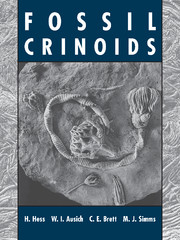Book contents
- Frontmatter
- Contents
- List of Contributors
- Acknowledgements
- Prelude
- Introduction
- GENERAL PART
- ASSEMBLAGES
- 6 Middle Ordovician Trenton Group of New York, USA
- 7 Middle Ordovician of the Lake Simcoe Area of Ontario, Canada
- 8 Upper Ordovician of the Cincinnati, Ohio, Area, USA
- 9 Silurian of Gotland, Sweden
- 10 Middle Silurian Rochester Shale of Western New York, USA, and Southern Ontario, Canada
- 11 Scyphocrinitids from the Silurian–Devonian Boundary of Morocco
- 12 Lower Devonian Manlius/Coeymans Formation of Central New York, USA
- 13 Lower Devonian Hunsrück Slate of Germany
- 14 Middle Devonian Windom Shale of Vincent, New York, USA
- 15 Middle Devonian Arkona Shale of Ontario, Canada, and Silica Shale of Ohio, USA
- 16 Lower Mississippian Hampton Formation at LeGrand, Iowa, USA
- 17 Lower Mississippian Burlington Limestone along the Mississippi River Valley in Iowa, Illinois, and Missouri, USA
- 18 Lower Mississippian Edwardsville Formation at Crawfordsville, Indiana, USA
- 19 Upper Pennsylvanian LaSalle Member, Bond Formation of Central Illinois, USA
- 20 Permian
- 21 Triassic Muschelkalk of Central Europe
- 22 Pentacrinites from the Lower Jurassic of the Dorset Coast of Southern England
- 23 Lower Jurassic Posidonia Shale of Southern Germany
- 24 Middle Jurassic of Southern England
- 25 Middle Jurassic of Northern Switzerland
- 26 Upper Jurassic Solnhofen Plattenkalk of Bavaria, Germany
- 27 Uintacrinus Beds of the Upper Cretaceous Niobrara Formation, Kansas, USA
- 28 Tertiary
- 29 Recent
- Appendix I Geological Time Table with Crinoid Assemblages
- Appendix II Glossary of Rocks
- Bibliography
- General Index
- Taxonomic Index
21 - Triassic Muschelkalk of Central Europe
Published online by Cambridge University Press: 10 November 2010
- Frontmatter
- Contents
- List of Contributors
- Acknowledgements
- Prelude
- Introduction
- GENERAL PART
- ASSEMBLAGES
- 6 Middle Ordovician Trenton Group of New York, USA
- 7 Middle Ordovician of the Lake Simcoe Area of Ontario, Canada
- 8 Upper Ordovician of the Cincinnati, Ohio, Area, USA
- 9 Silurian of Gotland, Sweden
- 10 Middle Silurian Rochester Shale of Western New York, USA, and Southern Ontario, Canada
- 11 Scyphocrinitids from the Silurian–Devonian Boundary of Morocco
- 12 Lower Devonian Manlius/Coeymans Formation of Central New York, USA
- 13 Lower Devonian Hunsrück Slate of Germany
- 14 Middle Devonian Windom Shale of Vincent, New York, USA
- 15 Middle Devonian Arkona Shale of Ontario, Canada, and Silica Shale of Ohio, USA
- 16 Lower Mississippian Hampton Formation at LeGrand, Iowa, USA
- 17 Lower Mississippian Burlington Limestone along the Mississippi River Valley in Iowa, Illinois, and Missouri, USA
- 18 Lower Mississippian Edwardsville Formation at Crawfordsville, Indiana, USA
- 19 Upper Pennsylvanian LaSalle Member, Bond Formation of Central Illinois, USA
- 20 Permian
- 21 Triassic Muschelkalk of Central Europe
- 22 Pentacrinites from the Lower Jurassic of the Dorset Coast of Southern England
- 23 Lower Jurassic Posidonia Shale of Southern Germany
- 24 Middle Jurassic of Southern England
- 25 Middle Jurassic of Northern Switzerland
- 26 Upper Jurassic Solnhofen Plattenkalk of Bavaria, Germany
- 27 Uintacrinus Beds of the Upper Cretaceous Niobrara Formation, Kansas, USA
- 28 Tertiary
- 29 Recent
- Appendix I Geological Time Table with Crinoid Assemblages
- Appendix II Glossary of Rocks
- Bibliography
- General Index
- Taxonomic Index
Summary
WITCHES’ MONEY AND CHICKEN LEGS: THE RESEARCH HISTORY OF ENCRINUS LILIIFORMIS
Long before the advent of scientific palaeontology, common fossils were connected with superstition and legends of popular belief (Abel 1939). In Lower Saxony the abundant columnals of the Muschelkalk sea lily Encrinus liliiformis were called Sonnenräder (sun wheels), and in Thuringia and Hessia they were called Bonifatiuspfennige (St. Boniface's pennies) because the saint who baptised the German tribes was said to have cursed all the pagan money, which turned into stone. In southwestern Germany, Encrinus columnals were called Hexengeld (witches’ money). According to a legend from Beuthen in Upper Silesia, in 1276 St. Hyacinth's rosary broke when he was praying at a fountain, and the beads dropped into the water. The saint prayed for them to multiply, and since then the fountain has been producing rosary beads: columnals of a diverse Middle Muschelkalk crinoid association (Hagdorn et al. 1996).
Therefore, it is not astonishing that columnals of Encrinus liliiformis were among the first crinoid remains described in the scientific literature. In his monograph, De natura fossilium (1546), Georgius Agricola from Chemnitz in Saxony introduced the name ‘Encrinos lilgenstein’, which means stone lily. However, he used this name for Chladocrinus columnals from the Lias of Hildesheim. For the cylindrical columnals of Encrinus liliiformis, Agricola coined the names ‘Trochites’ (wheel stones, a translation of their trivial German name, Rädersteine) for single columnals and ‘Entrochus’ for pluricolumnals. A hundred years later, Fridericus Lachmund, in Oryctographia Hildesheimensis (1669), illustrated columnals, cups and cup elements (Pentagonus) as well as a fragmentary crown, the arms of which he compared to chicken legs.
- Type
- Chapter
- Information
- Fossil Crinoids , pp. 164 - 176Publisher: Cambridge University PressPrint publication year: 1999
- 10
- Cited by



